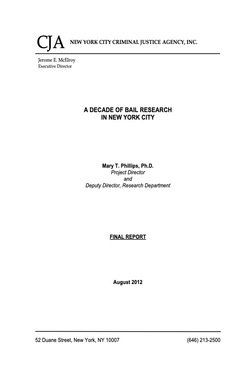A Decade of Bail Research in New York City
By Mary T. Phillips
A decade-long research project examining the bail system in New York City has recently been completed by the New York City Criminal Justice Agency, Inc. (CJA). The research was conceived in the context of CJA’s mission of reducing unnecessary pretrial detention, and it continued in the midst of a national debate about the role of bail and the commercial bail bond industry in the criminal justice system. With the publication in 2011 of the last of a series of reports from this research, it is now time to take stock of what we have learned, and to consider how the findings might inform the ongoing public discussion. This final report of the bail project synthesizes the major findings, with the dual objective of making the research results more accessible by gathering them together in one place, while also introducing a level of clarity that is difficult to achieve when disparate findings are viewed only as separate pieces. The bail research began in 2002 with a pilot project to determine the feasibility of collecting data from courtroom observations that would be of use in examining the factors that enter into judges’ decisions to release or set bail for defendants at arraignment. The first published report from that study appeared in 2004. Findings from each phase of the research raised further questions, leading us to expand the study to investigate the part played by the prosecutor in the judge’s bail decision, the role of commercial bonds in bail release, the association between release type and failure to appear (FTA), and the effects of pretrial detention on case outcomes. All together, eight full reports and seven Research Briefs were published between 2004 and 2011 presenting the results of the bail project. They are listed together in a separate section at the beginning of the References, and all are available on CJA’s website at www.nycja.org/research/research.htm.
New York; New York City Criminal Justice Agency, 2012. 171p.


